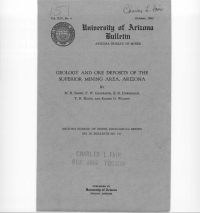Location, Culture, and Transportation
The Superior mining area is in northeastern Pinal County, Arizona (Fig. 1). The area was officially organized as the Pioneer mining district but is better known as the Superior mining area.
Superior, the principal settlement within the area, in 1940 had a population of about 5,000, depending principally upon operations of the Magma Copper Company. The old town of Silver King, now largely deserted, was at the Silver King mine, in the northern part of the area shown on Plate I.
The Magma Arizona Railroad, 35 miles long, extends from Superior to Magma, a station on the Winkelman branch of the Southern Pacific, 9 miles west of Florence. It is maintained by the Magma Copper Company. Superior is on U.S. Highway 70, about 64 miles east of Phoenix and 20 miles west of Miami. A graveled state highway extends from Superior to Ray, 15 miles south. A graded county road 7 miles long connects Superior with Silver King. Various secondary roads lead to ranches and mines.
Physiography
Superior is on the eastern margin of a basin-shaped valley in the mountainous region between the Superstition and Pinal ranges. The Superior mining area, as here considered, consists of a central northward-trending mountainous belt 3/4 to 3 miles wide which rises eastward from this valley to a mesa.
The Central Belt ranges in altitude from about 2,800 feet at Superior to a maximum of 4,500 feet below Apache Leap, the rim of the mesa. It consists largely of faulted eastward-dipping limestone, quartzite, and shale, underlain by schist and including areas of intrusive diabase, diorite, and porphyry (Pl. I). Its topography reflects somewhat the bedrock character and structure. Semiarid, rapid erosion has formed cliffs and steep slopes upon resistant limestone and quartzite; medium slopes or rounded hills upon uniformly textured diorite; and gentle slopes upon shale and diabase. The trend of the mountain front follows rather closely the strike of the beds, as shown on Plate I.
The Valley extends west from Superior, along the drainage of Queen Creek, beyond the limits of Plate I. It is bounded on the east by the Concentrator fault and appears to be of tectonic origin. Its margins are floored by a pediment of dacite conglomerate and older rocks, and its inner area is covered by gravel and silt suggestive of fluviatile and lacustrine deposition. Recent erosion has dissected its surface to a moderate extent.
The mesa extends east from Apache Leap to the Pinal Mountains, beyond the margin of Plate I, and ranges in altitude from approximately 4,500 feet on the southwest to 5,530 feet at King's Crown, on the northwest. This mesa is floored by a thick series of volcanic flows and tuffs overlapping a deeply eroded, beveled surface of the rocks of the Central Belt. In general conformity with its surface structure, the mesa slopes gently eastward for about a mile from Apache Leap and flattens along the eastern margin of Plate I. In places the rock exfoliates into rounded forms, but more commonly it erodes along vertical joints into pinnacles and cliffs.
The east-west earlier faults and mineralized veins as a rule have little or no topographic expression. Later faults have guided erosion but left few prominent scarps.
Drainage of the Valley, Central Belt, and part of the mesa is by ephemeral streams tributary to Queen Creek, which carries sufficient water during a few months of the year to provide an auxiliary supply for Superior. The drainage pattern on the mesa is determined partly by dip and partly by joints and fissures in the lava. On the Central Belt the drainage is parallel with, or at right angles to, the strike of bedding except where guided by faults. As shown by Plate I, the streams enter the Valley at right angles to the Concentrator fault.
Short, M.N., F.W. Galbraith, E.N. Harshman, T.H. Kuhn, and E.D. Wilson. 1943. Geology and Ore Deposits of the Superior Mining Area, Arizona. Arizona Bureau of Mines, Geological Series No. 16, Bulletin 151. Tucson, Arizona: University of Arizona. October.


